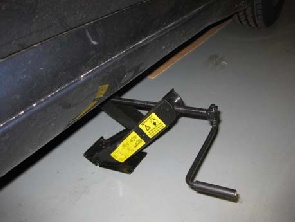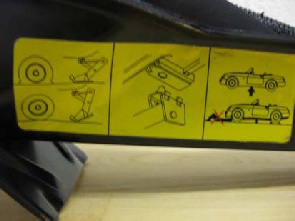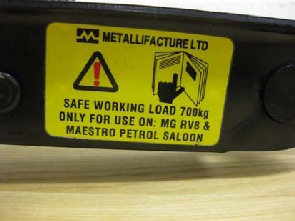331
How
safe is the jack in your RV8?
Shortly after Chris Allan purchased his 1994 RV8 (Flame Red
1192) he decided to check the contents of the tool tray located
within the spare wheel centre. What he found was not reassuring.
(Aug 10)
Chris was already aware that his car did not come with
an RV8 tool roll, but decided to check that he had the tools
required in case of a flat tyre. Everything was there, the jack,
wheel brace, Allen key and the locking wheel nut removal key.
On inspection, however, it was clear from its label that the
jack was not original as it was stated that the jack was for
use only on the Rover200/400 and Honda Concerto and had a Safe
Working Load of 625kg. As it is likely that most owners don't
give their car jack a second thought until they have a flat
tyre, and then they probably assume that it will be up to the
job, Chris felt he clearly needed to investigate further and
did so via a question on the V8 Bulletin Board.
Angus Munro responded and was able to provide details of the
original RV8 jack and also kindly supplied the photographs of
the correct RV8 jack which are reproduced below.

The original jack is of the half scissor (aka a Y or boomerang)
design and is raised or lowered by a handle which operates a
screw mechanism. The jack, including the screw mechanism, should
be sprayed satin black.

There's a locating peg which fits in the car's jacking point.
The jack can be readily identified by the two gummed yellow
paper labels which should be attached thereto. The larger label
shows three pictures:
> A flat and inflated tyre and the associated angle
the jack takes up depending upon the ground clearance available
to it.
> How to locate the jack locating peg into the car's
jacking point.
> Two pictures of the RV8 showing where to jack the
car, and warning against working under an RV8 which is only
supported by a jack.

The second yellow sticker carries the following information:
> Metallifacture Ltd - the manufacturer.
> Safe Working Load 700 kg.
> Only for use on the MG RV8 and Maestro Petrol Saloon
[sic].

On the underside of the jack will be a number of characters
stamped into the metal frame which relate to the date of manufacture.
The format is as follows:

|
Either
one or two numbers are the week of manufacturer - so the range
is 1 to 52. There is a single letter which is day of the week
of manufacture so an "A" is a Monday through to "E"
which is a Friday. Finally there are two numbers which are the
last two numbers of the year of manufacture, so we would expect
to see "92" through to "95".
Those
RV8 owners who are interested in originality may wish to compare
the date on their jack against the date of their vehicle's manufacture.
If the labels are missing, I am not aware that there are any
other identifying marks which will enable the owner to confirm
whether or not their jack is correct for the vehicle.
Instructions
on the proper use of the RV8 jack are detailed in the RV8 Owner's
Handbook in the section headed "Wheel Changing", pages
106-108. Of particular import is the following extract from
page 106 - "NEVER work beneath the car with the jack as
the only means of support. The jack is designed for wheel changing
only!" Reference is also made to the importance of only
carrying out a lift on firm and level ground and to the correct
use of the vehicle chocks.
Next
Chris decided to contact the technical department of Adwest
Ltd, the successor to Metallifacture Ltd the manufacturer of
the original RV8 jack. The information/advice provided by them
is detailed below:
> The
design of the RV8 jack (known as a½ scissor, Y or boomerang
design) can, in certain circumstances, cause it to be unstable
in that it is liable to twist if it is subjected to any vehicle
movement. Even with the use of the vehicle chocks provided with
the RV8 some movement is possible. It should be noted that the
wheel chocks should always be utilised when jacking up the car:
a chock should be securely placed both at the front and rear
of the wheel diagonally opposite to the wheel being removed.
If the lift is attempted on anything other than firm/level ground
(the flat tyre may not always be experienced at a suitable location),
then the safety of the lift is brought further into question.
> Adwest did not have specific information to hand
regarding the testing regime to which the RV8 jack had been
subjected. However, the fact that it was also used on the Maestro,
and that the RV8 was such a low volume vehicle increase the
possibility that the jack supplied with the car was sourced
from the existing Rover parts bin. It may not, therefore, be
ideally suited to the RV8 application.
> The weak point of any jack of this design is the
screw. On Metallifacture's higher specification jacks, the screw
mechanism is phosphate coated while the RV8 jack's screw mechanism
is sprayed satin black, and is thus of a lower specification.
Owners should ensure that this, and the associated bearings
etc., are properly greased. In addition, although the screw
and bearings should attract particular scrutiny, owners should
check that all parts of the jack are in serviceable condition.
> The jack is only tested by the manufacturer for
its capability to make up to10 lifts. This is a notional figure
based on a maximum of 3 flat tyres being expected during the
vehicle's warranty period, plus additional lifts for those drivers'
who need to change between summer and winter tyres over these
3 years (common practise in Northern Europe). A particular jack
maybe safe for additional lifts, but it could be viewed as reckless
to assume that this is necessarily the case. [As you may not
be the original owner and your vehicle is likely to be at least
15 years old, do you know how many lifts your jack has already
made?]
> Since 1998, the supply by vehicle manufacturers
of jacks to this design and standard of manufacture would be
illegal as they would not meet the requirements necessary to
be awarded the "CE" mark.
> When considering an aftermarket jack, especially
any scissor or ½ scissor jack, purporting to be for universal
application, caution should be exercised.
> Adwest Ltd are keen to point out that nothing in
this advice in any way constitutes a recommendation from them
as to the suitability of a jack supplied with the RV8 for lifting
the vehicle. On the contrary, their advice is that, in the interest
of safety, owners should not use their RV8 jacks. Rather, they
recommend owners call out a rescue service. An alternative would
be to use a propriety brand of tyre sealant/weld, although they
recognise that there are also issues here which need to be considered
in the light of specific circumstances. They also recommend
that in the workshop/garage environment, prior to work commencing
either at the side or under the vehicle, a suitable trolley
or bottle jack should be appropriately positioned and used to
lift the vehicle to enable the correct placement of axle stands
or other suitable supports.
> It should be noted that Adwest Ltd does not have
any ongoing responsibility to provide service for these jacks.
Unless any third party holds "new old stocks", the
only source is likely to be through the secondhand market with
the inherent uncertainties attached thereto.
It is clearly for individual members to decide on the appropriateness
of Adwest's advice to their particular circumstances, but it
can be taken as read that members will consider their own and
other's safety as paramount. Members may also wish to consider
the following, which must be considered as purely personal experiences/views.
Angus only has had need to use his jack (original and previously
unused) on the one occasion when he had a flat tyre. He noticed
that it took a great of effort to achieve a full lift (possibly
the jack needed greasing?) and he was also alarmed to see some
buckling of the frame of the jack. He subsequently purchased
a racing trolley jack and does not intend to use the original
jack again.
Chris' personal preference (once he has obtained the correct
jack), is to use it to achieve sufficient lift to enable a bottle
jack to be put in place and then to complete the lift with the
bottle jack. He would not remove the wheels from the vehicle
when the only form of support is the car's jack. The procedure
would of course be reversed when lowering the vehicle. See
the note as a PDF document |



